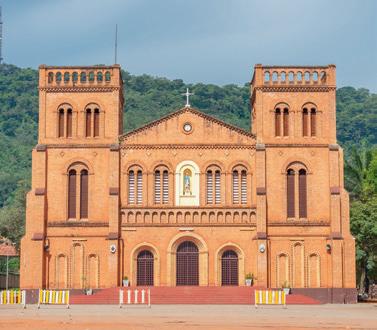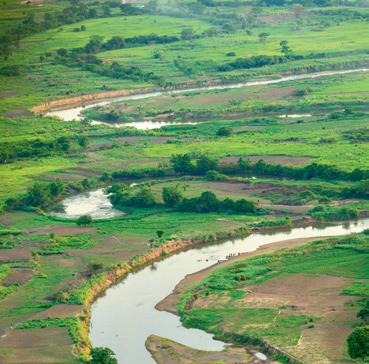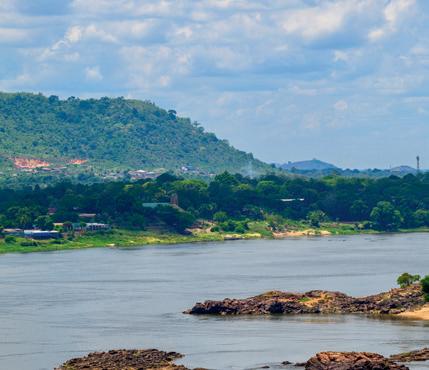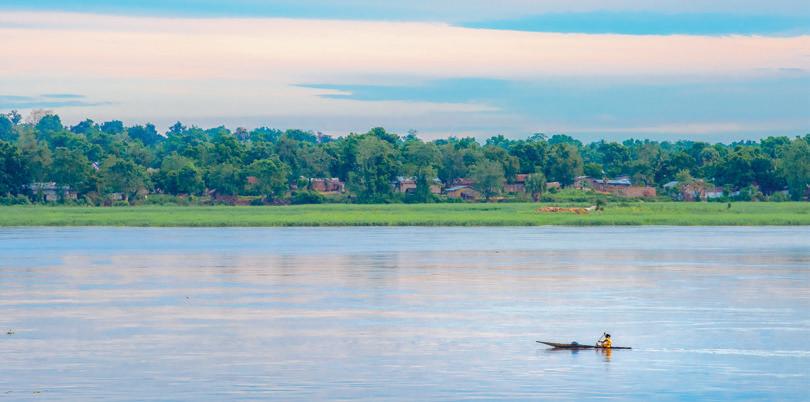
5 minute read
The best of Bangui
Bangui attracts only the most intrepid of tourists, but the city has largely escaped the civil unrest that has beset the rest of the Central African Republic (CAR) in recent years. This vibrant riverside capital is a hidden gem waiting to be discovered by the bold. Inzozi uncovers some of its wonders.
Riverside living
The Ubangi River is the lifeblood of Bangui. It flows south of the city for around 100 km before emptying in the Congo and provides a vital trade link with Brazzaville, the Democratic Republic capital. Upstream of Bangui, the river soon hits a section of turbulent water that prevents further travel north and gives the city its name – ‘Bangui’ is the word for rapids in the local Bobangi language. The Ubangi is rich in fish, including the Goliath Tigerfish, an enormous specimen with a seriously scary set of teeth that has earned it the nickname of ‘river monster’. Locals will be glad of the extra income that comes from taking a visitor out on a fishing trip or a sunset cruise. Longer river voyages out of the city are best organised through a registered tour company and offer the chance to visit the coffee farms and remote riverside communities downstream.
Canoe races
If you are lucky enough to be in Bangui during a public holiday – such as the CAR’s Republic Day on August 1 or National Day on December 1 – you’ll see one of the city’s most spectacular sights. Teams of locals from rival riverside tribes race against each other in canoes made by hollowing out tree logs. Spectators gather along the banks of the Ubangi to cheer on the competitors as they paddle through the foaming water. The victorious team wins a life-changing cash prize for their communities as well as plenty of local pride.
Food scene
The riverside in Bangui is also a picturesque spot to savour local cuisine away from the clamour of the city centre. Auberge Saint-Flour offers cuisine inspired by the city’s French colonial heritage as well as spectacular views over the Ubangi. Other riverside dining options include La Tourangelle, known for its riverside balcony, and Restaurant de l’Oubangui, which is located on a rocky outcrop that that neighbours a beach from which fishermen launch their boats. Take the opportunity to try some local dishes such as peanut soup and fufu or street food favourite makara, a type of fried bread.

A city inspired by Paris
It takes a leap of imagination to see it, but the urban layout of bustling Bangui is believed to have been inspired by the order and grandeur of the French capital. Both cities have wide boulevards – most in Bangui are unpaved – and both have striking Notre Dame cathedrals. The one in Bangui was built in 1937 with a symmetrical double-tower design inspired by its 12th century counterpart in Paris. The Notre-Dame of Bangui Cathedral serves as the seat of the Archdiocese of Bangui and has been visited by Pope Francis. Other Parisian touches in the city include an Arc de Triomphe. Bangui’s was built in the 1970s to honour the then-president Jean-Bédel Bokassa. The monument is located in a grand square known to locals as ‘PK0’ or ‘Point Kilometre Zero’. Like ‘Point Zero’ in Paris it marks the point where distances to the rest of the country are measured. If you stand at the middle of the square, you can spot the opulent Presidential Palace – another architectural reminder of Bokassa’s rule.
Marché Central
Like all African cities, Bangui’s traditional commercial heart is its markets. The biggest of its kind in the CAR capital is the Marché Central. Located next to PK0, this mustsee marketplace sells fresh produce from surrounding farms as well as spices, and even live chickens. The sprawling market has even started taking over neighbouring streets with stalls selling artisanal furniture, jewellery, and traditional handicrafts such as masks and baskets. Knowing a few phrases in either French or Sango (a language from the Ubangi River region spoken by about 90 per cent of locals) will help with the haggling.

Explore the cultural heritage
Housed in a colonial villa in the centre of the city, the Boganda National Museum provides insights into the diverse culture of the CAR – a country that is home to over 80 distinct ethnic groups. Handicrafts on show include an impressive collection of delicately crafted ebony and ivory statuettes – an art form that has been a staple of Central African culture for centuries.

Chutes de Boali
If you are looking for a day trip from Bangui that is a world away from the capital’s urban bustle, seek out Chutes de Boali. This 250-metre-wide series of waterfalls northwest of the capital has been called the ‘Niagara Falls of the Central African Republic’. Its raw power is most evident during the rainy season from July to September when torrents of water plunge 50 metres to the crocodile-infested pools below.









